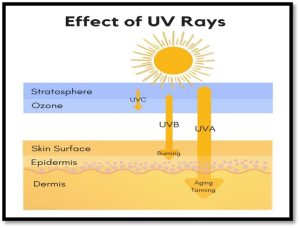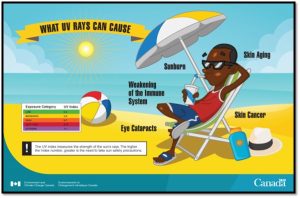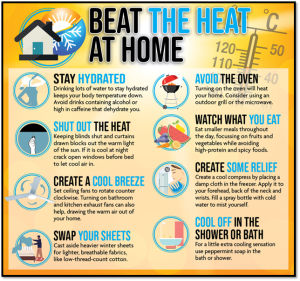BEAT THE HEAT
By Alyssa Jairam

1.0 Theory – Why Is The Weather So Hot?
Is it hot? Have you been sweating a lot lately even with the air conditioner ON or if you step outside for a few minutes? Recently, our bodies have been very heated with no signs of easing. The Heat Index (HI) is what the temperature feels like to the human body when relative humidity is combined with the air temperature (NOAA, 2023). This is important for the comfort of our bodies as when the body gets too hot, it begins to perspire or sweat to cool itself off. In fact, the hottest date in Trinidad and Tobago for this year has been recorded on 24th August, 2023. Piarco was 33.8°C (92.84°F) while Crown Point was 31.8°C (89.24°F) (Trinidad and Tobago Weather Center, 2023). However, on this date, the maximum heat index was recorded as 52°C (125.6°F) in Trinidad which is considered as ‘Extreme Danger’ while in Tobago, the maximum heat index was 46°C (114.8°F) which is classified as ‘Danger.’

Figure 1: Maximum heat indices recorded across Trinidad and Tobago on Thursday 24th August, 2023. | Source: TT Weather Center

Figure 2: Heat Index (HI) and its effects on the human body. | Source: National Oceanic and Atmospheric Administration
There are various reasons for the increase in global temperatures which are making the world incredibly hot. These are as follows:
- El Niño: This is climate pattern known as the ‘Warm Phase’ that involves the unusual warming of surface waters in the eastern equatorial Pacific Ocean (National Geographic, 2023). As such, trade winds and the atmosphere are impacted. One reason for the extra heat is due to a significant El Niño that is still strengthening. This warming and the effects of El Niño in other parts of the world can cause global average temperatures by rise about 0.1 to 0.2°C (King, 2023).

Figure 3: El Niño effect. | Source: Legacy IAS Academy
- Increased Solar Activity: Approximately every 11 years, the sun experiences periods of low and high solar activity. Over the course of a solar cycle, the sun will transition from a calm to an intense and active period. Since 2019, the sun has been becoming more active which contributes to a spike in global temperatures. A point of Solar Maximum is reached which is the peak of the sun’s activity and can persist for years (Strickland, 2023).
- Greenhouse Gases and Climate Change: Energy from the Sun reaches the Earth’s surface and is radiated back into the atmosphere as heat. Greenhouse gases prevent some of that heat from leaving the atmosphere since greenhouse gas emissions create a blanket that envelops Earth, thereby trapping the Sun’s heat. The recent increase in greenhouse gas pollution traps excess heat which causes the climate to warm. Additionally, emissions of pollutants into the atmosphere such as generating heat and electricity from the combustion of fossil fuels can result in Climate Change which is the long-term shifts in temperatures and weather patterns. The main driver of Climate Change is anthropogenic activities such as the burning of fossil fuels (coal, oil and gas) which produce heat-trapping gases leading to increased temperatures worldwide (United Nations, 2023).

Figure 4: Guide to the greenhouse effect. | Source: Environmental and Energy Study Institute (EESI)
2.0 What Are The Effects of Excess Sun Exposure On Human Health?
As a kid growing up, we have always been told by our elders that a small amount of sunlight is good for us as it creates vitamin D which absorbs calcium. Our bodies need calcium in order to build and maintain strong, healthy bones (Family Doctor, 2020). However, too much exposure to the sun is harmful and can lead to various health effects.
The sun gives off rays of light known as ultraviolet (UV) rays. The three (3) different types of UV rays are (Alexander, 2019):
- UVA Rays – This is the most common form of sun exposure and accounts for 95% of all the UV rays that reach the Earth’s surface. UVA penetrates deep into our skin which causes skin damage and tanning.
- UVB Rays – This only makes up 5% of the radiation from the sun however, it is more intense. While UVB rays do not penetrate the skin as deeply as UVA rays, it can cause damage to the top layer of your skin by destroying skin cells and causing DNA mutations which can lead to skin cancer.
- UVC Rays – This is the worst type of radiation from the sun however, the Earth’s ozone layer blocks these rays from reaching us on Earth. The only way humans can be exposed to UVC rays is from an artificial source such as a lamp or laser (FDA, 2023).

Figure 5: Effects of UV rays. | Source: Harken Derm LLC.
Too much exposure to the sun can lead to the following:
- Sunburn: This causes skin cells to die, damage or develop cancer. Signs of sunburn include skin redness, itchy or tight skin, pain, blisters and peeling of the skin.
- Early Aging: Too much exposure to the sun causes your skin to age faster. The skin can become leathery, wrinkled and dark spots may develop.
- Lowered Immune System: Since white blood cells protect our bodies from infections and foreign molecules, if our skin is exposed to the sun for too long, the white blood cells will need to generate new skin cells which puts your immune system at risk in defending your body in other areas.
- Eye Injury: Rays from the sun causes damage to your eye tissues as UV rays can burn the cornea (outer layer). This can lead to impaired vision, the development of Cataract and cause blindness overtime if left untreated.
- Skin Cancer: Too much UV radiation from the sun can damage the DNA in our skin cells. Overtime, cells can grow out of control, leading to the development of skin cancer (Cancer Research UK, 2021).
- Dehydration: This occurs when more water is moving out of our cells and bodies as compared to the amount of water that we consume. Dehydration causes body fluid levels to become unbalanced and severe dehydration can lead to death. Signs of dehydration include: urine being dark yellow in colour, increased thirst, decreased urine output, inability to sweat, dizziness and weakness, dry mouth and swollen tongue, heart palpitations, fainting, confusion and sluggishness.
- Heat Stroke: This may begin as heat cramps, fainting or exhaustion, but as it progresses, it can damage the brain and other internal organs. When combined with dehydration, prolonged exposure to extreme heat causes the body’s temperature control system to fail which results in body temperature being greater than 105°F. Common symptoms of heat stroke include: dizziness and light-headedness, headache, nausea and vomiting, muscle cramps or weakness, rapid heartbeat, rapid and shallow breathing, confusion, disorientation, staggering, seizures and loss of consciousness (Revere Health, 2016).
- Hives: These are large, itchy red welts that develop within 5 minutes of sun exposure and usually disappear within an hour or two after leaving the sunlight. People with this rare condition experience headaches, weakness and nausea. Worldwide, 3.1 per 100,000 people are affected from this skin reaction (Revere Health, 2016).

Figure 6: Health effects associated with excess exposure to UV rays. | Source: ECCC Weather Ontario
3.0 How Can I Beat The Heat?
Some tips for keeping cool in hot weather are (Johns Hopkins University, 2023):
- Use Sunscreen: The higher the SPF, the more it will protect against UV rays. The FDA suggests using SPF 30 or greater as broad-exposure sunscreen blocks out both UVA and UVB rays. Sunscreen should be applied approximately 30 minutes before going outside and should be applied to areas that are often overlooked such as your ears and hairline. Sunscreen should be reapplied every 2 hours even after swimming or sweating.
- Plan Your Exposure: Avoid direct sun between the hours of 10am – 4pm as this is when the sun’s rays are the strongest. As much as possible, try to stay in shaded areas or use an umbrella.
- Cover Up: You should wear lightweight clothing, sunglasses and hats to protect your skin from UV rays. Protective clothing can include: long-sleeved shirts that cover your arms, pants that cover your legs and a wide-brimmed hat. Clothing can also have a UV protection factor (UPF) or made of a tightly woven fabric.
- Stay Hydrated: Drink lots of water to keep your body temperature’s down and avoid drinks that contain a lot of sugar, caffeine and alcohol which causes dehydration.
- Have a Healthy Diet: Ensure that you get your vitamin D by consuming foods such as fish, eggs, milk and mushrooms or take vitamin D supplements.
- Be Cautious Near Reflective Surfaces: Water, snow and sand reflect the damaging rays of the sun which increases your chances of sunburn.
- Invest in Thermal Curtains: Thermal curtains create a seal between the fabric and the windowpane which block heat from entering a room. Thermal curtains are also affordable as a single panel is less than TT$100.
- Use Cross-Ventilation: This involves opening windows on opposite sides of your house which will ensure that fresh air flows through and circulates within the space.
- Examine You Skin: You should inspect your entire skin on a regular basis for any changes, growths or bleeding. If detected, visit a healthcare provider immediately. Skin cancer is very treatable when detected early.

Figure 7: Tips to beat the heat. | Source: Town of Pelham
References
- Alexander, H. 2019. “What’s the difference between UVA and UVB rays?” Retrieved from The University of Texas MD Anderson Cancer Center: https://www.mdanderson.org/publications/focused-on-health/what-s-the-difference-between-uva-and-uvb-rays-.h15-1592991.html
- “Effects of Sun Exposure.” 2020. Retrieved from Family Doctor: https://familydoctor.org/effects-early-sun-exposure/
- “El Nino.” 2023. Retrieved from National Geographic: https://education.nationalgeographic.org/resource/el-nino/
- “Five Dangers of Prolonged Sun Exposure.” 2016. Retrieved from Revere Health: https://reverehealth.com/live-better/5-dangers-of-prolonged-sun-exposure/
- “Global Temperature Change.” 2023. Retrieved from NASA: https://earthobservatory.nasa.gov/world-of-change/global-temperatures
- “How Does The Sun and UV Cause Cancer.” 2021. Retrieved from Cancer Research UK: https://www.cancerresearchuk.org/about-cancer/causes-of-cancer/sun-uv-and-cancer/how-does-the-sun-and-uv-cause-cancer
- King, Andrew. 2023. “Six Reasons Why Global Temperatures Are Spiking Right Now.” Retrieved from The Conversation: https://theconversation.com/6-reasons-why-global-temperatures-are-spiking-right-now-215140
- National Oceanic and Atmospheric Administration (NOAA). 2023. “What Is The Heat Index?” Retrieved from https://www.weather.gov/ama/heatindex
- Rowlatt, Justin. 2023. “Excessive Heat: Why This Summer Has Been So Hot?” Retrieved from BBC News: https://www.bbc.com/news/science-environment-66143682
- “Staying Cool In Summer: Top Tips To Keep Cool In Hot Weather.” 2023. Retrieved from British Red Cross: https://www.redcross.org.uk/stories/health-and-social-care/first-aid/beat-the-hot-weather-top-tips-for-staying-cool
- Strickland, Ashley. 2023. “The Sun’s Activity Is Peaking Sooner Than Expected.” Retrieved from CNN: https://edition.cnn.com/2023/07/14/world/solar-maximum-activity-2024-scn/index.html
- “Sun Safety.” 2023. Retrieved from The John Hopkins University: https://www.hopkinsmedicine.org/health/wellness-and-prevention/sun-safety
- “Trinidad Records Hottest Day For 2023.” 2023. Retrieved from TTWeather Center: https://ttweathercenter.com/2023/08/24/trinidad-records-hottest-day-for-2023-to-date-again/
- “Ultraviolet (UV) Radiation.” 2023. Retrieved from US Food and Drug Administration: https://www.fda.gov/radiation-emitting-products/tanning/ultraviolet-uv-radiation
- “What Is Climate Change?” 2023. Retrieved from United Nations: https://www.un.org/en/climatechange/what-is-climate-change
